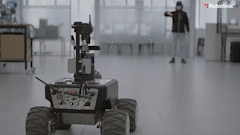Smarter robots, more autonomous robots, and more useful robots: Robotnik explores some of the most interesting questions about AI and robotics.
Robotnik’s Autonomous Mobile Robots (AMR) are capable of operating autonomously, navigating collaborative environments without the need for human intervention, thanks to various sensors, cameras, and other advanced technologies that allow them to perceive the environment, make decisions and execute tasks.
The evolution of Artificial Intelligence (AI) enhances the functionality and autonomy of AMRs, enabling them to operate more intelligently through Machine Learning and Deep Learning algorithms. This ranges from the use of personal assistants to advanced manufacturing devices or surveillance robots.
HOW DOES ARTIFICIAL INTELLIGENCE WORK IN ROBOTS?
The foundation of an intelligent robot is Artificial Intelligence, a branch of IT that seeks to create systems capable of performing tasks that would otherwise require human intervention. Intelligent robots are equipped with machine learning algorithms, allowing them to acquire knowledge from data and improve their performance over time.
Intelligent robots use complex algorithms to process information and make decisions. Data input comes from a variety of sources, such as sensors, cameras, and other perception devices. This data is then processed through neural networks, systems that mimic the structure and function of the human brain. During this process, the robot learns patterns and correlations, enabling it to perform specific tasks more efficiently.
The broad range of applications arising from the synergy between AI and robotics is indicative of its significant utility for humans in work, personal, social, healthcare, or security settings. In the case of a security robot, sensors collect environmental data, and through AI algorithms, this data is processed and analyzed to make relevant decisions.
En el caso de un robot de seguridad, los sensores recopilan datos ambientales y, mediante algoritmos de IA, estos datos son procesados y analizados para tomar las decisiones pertinentes.
HOW DO AI SURVEILLANCE ROBOTS ASSIST HUMANS?
- Continuous Monitoring:
Surveillance robots with AI are designed to operate autonomously, meaning they can monitor environments continuously without constant human intervention. This is particularly valuable in critical security environments, such as electrical or energy installations, where uninterrupted surveillance is essential. - Advanced Detection:
Equipped with advanced sensors, such as high-resolution cameras and motion detection systems, these robots can identify and track objects of interest efficiently. The capability of machine learning also allows robots to improve their ability to recognize patterns and behaviors, leading to more precise detection. - Rapid Response to Threats:
In the security realm, response speed is crucial for the early detection of potential dangers. AI surveillance robots can react instantly to suspicious events, alerting human operators and taking preventive measures as per pre-established programming. This capability enhances the effectiveness of security operations and reduces response time to potential threats. - Comprehensive Coverage:
The mobility of robots like RB-WATCHER allows them to patrol extensive areas and access hard-to-reach places for humans. From urban areas to natural environments, these robots can provide comprehensive coverage, improving surveillance efficiency and responsiveness. - Reducing Risks for Humans:
By taking on surveillance tasks in potentially dangerous environments, such as conflict zones or disaster-prone areas, AI surveillance robots reduce risks for humans. This not only enhances the safety of operators but also enables exploration of challenging environments without exposing humans to potentially hazardous situations.


CONCLUSION
The intelligent robots evolve continuously as Artificial Intelligence advances. In the short term, new applications will emerge, addressing more complex tasks while improving the precision and efficiency of current ones, especially in the field of surveillance. This represents an innovative solution to enhance security in critical environments and reduce risks for humans.
A FAQ about AI robots
An intelligent robot is characterized by its ability to continually learn and adapt to new situations through the incorporation of advanced artificial intelligence systems. Unlike conventional robots, these devices can make autonomous decisions based on information received from their environment.
Artificial intelligence significantly enhances a robot’s capabilities by enabling it to process data more sophisticatedly, learn from experience, and improve performance over time. This dynamic learning capability is crucial for intelligent robots to perform increasingly complex and efficient tasks.
Intelligent robots have various applications in today’s society, from home assistance and healthcare to advanced manufacturing and autonomous surveillance. These devices are used to execute specific tasks autonomously, freeing humans from dangerous tasks and improving efficiency across various sectors.



